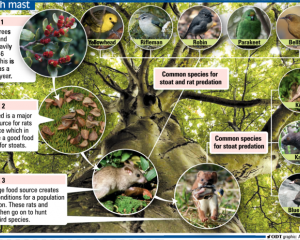The Parliamentary Commissioner for the Environment, Jan Wright, is no friend of the establishment. She made herself unpopular with the Government in her vocal opposition to mining of the conservation estate; she has raised the red flag over Solid Energy's plans for lignite extraction; she opposed the former Labour-led government's policies on biofuels.
So what is she doing not only endorsing the Department of Conservation's use of 1080 poison, but advocating for an extension of the same? There is, after all, considerable and vocal opposition to the blanket use of the pest control agent.
That opposition is based on a number of factors including 1080 is toxic to placental mammals other than those at which the poison is aimed, and in particular it is harmful to humans, dogs and deer if ingested in sufficient concentrations; it is argued it does not work - that it kills the very species, our native birdlife, it is applied to protect; that it kills insects; and that it poses an insidious threat to human health through potential infiltration and pollution of soil and the water table.
There is some truth in all this. It is true, for instance, that in years past 1080 aerial drops have been conducted with less than pinpoint accuracy and at dosage rates that far exceed those now deemed sufficient for purpose.
In some areas, and on some past occasions, birdlife has been observed to decrease following heavy and unmitigated aerial drops. And like all other chemical agents, 1080 can and will leach into the soil and groundwater, or lie on the surface posing risks to dogs and deer.
But more recent usage, managed with sophisticated GPS technology for accuracy of coverage, and smaller more precisely attuned dosages avoids many of these problems. Trials have shown that by and large bird life is unaffected directly by such drops.
And controlled applications of 1080 augmented by trapping, as opposed to trapping alone in adjacent valleys - aimed at eradicating predator life - have shown a vast disparity in the resultant population densities of threatened birdlife in favour of the poison.
Its supporters, of which there are many, point out that unlike other poisons, 1080 breaks down rapidly in the environment and that, while certainly toxic, huge quantities of contaminated plant or animal would have to be consumed to cause significant human harm.
They say that its optimal use is much better understood than in the bad old days of vast overdosing in pursuit of the rabbit control for which it was first introduced.
Having studied the evidence for and against the use of 1080 in New Zealand, Ms Wright is unequivocal in her report: there is no suitable alternative. Failure to sustain, indeed increase, its use will see our forests eventually fall silent.
At stake to the predations of predominantly possums, rats and stoats is not only our flora but much of our native fauna, which faces extinction unless there is successful intervention.
The breeding cycle and fecundity of these predators reads like a horror story, swelling populations uncontrollably. Over time, kakapo, mohua, kereru, kokako, kiwi, saddlebacks, parakeets and many other species stand little chance against them.
Ms Wright's report will not, of course, convince everyone, but it has united in support of continued 1080 use a number of unlikely bedfellows: the National Party, the Labour Party, the Green Party, Federated Farmers and Forest and Bird to name just a few.
Ranged against her are a number of individuals and organisations convinced of the poison's inefficacy, including United Future's Peter Dunne who, long aligned to outdoor sporting interests such as deer hunters, has been claiming his own expertise in the matter, insisting 1080 does not work.
Introduced predators are destroying our native forests and much of the precious wildlife within them (to say nothing of the bovine Tb threat from wild animal pests to our agricultural industries).
Ms Wright's report is a timely corrective, and 1080 the most effective and least environmentally corrosive of all the weapons at the disposal of those to whom we entrust the safeguarding of our heritage. That is not to say alternatives to 1080 should not be sought or developed, but for now the message is clear: use it or risk losing our natural and native heritage forever.







